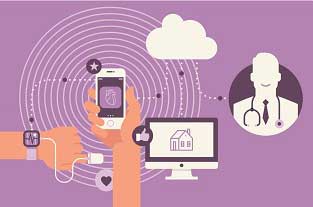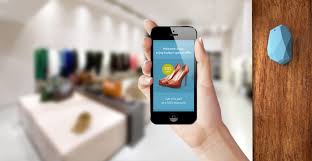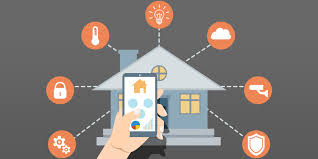We are the most
Experienced IoT System
Integrator
We deliver complex, comprehensive and custom solutions

We are hired to create a IoT system out of disparate components of hardware and software and ensure that the pieces work together. We are the best IoT System integrator to deliver complex, comprehensive, and custom solutions.
The Internet of Things provide everything you need to generate data-driven intelligence from connected things, people and devices. Connect your business with the new generation of Internet-enabled devices in the cloud, transform your existing business processes and reimagine your business and customer experience.

We have already implemented a wealth of projects, for example in various use cases of Smart Retail and Smart Health, Smart Home and Smart City. We support you across all phases of your IoT projects – from the development, to implementation of your connected solutions up to a stable and reliable operation.

The patient has four IoT devices, together costing less than $300: a connected weight scale, a blood pressure cuff, a smart pillbox, and a wristband that tracks his heart rate and blood oxygen level. These devices quickly detect a change in his condition: he is getting fatigued more quickly during his daily walks, and he has been missing some of his medication over the holidays. Importantly, the scale also picks up that he has put on 2 kilograms in only a few days—a sign of increased fluid retention that should prompt an immediate call to his physician and perhaps an increased dosage of his diuretic. His doctor receives an alert with all this information and calls the patient to schedule an immediate appointment. He reminds the patient how important it is not to skip the diuretic. In a visit the following week, the doctor sees that the patient’s weight has dropped and he is able to breathe easily during normal activities. The doctor reminds the patient that he needs to follow a careful diet and take his medications faithfully, even during holidays. The patient also receives in-office education about the warning signs of increased weight and how a rapid response can avoid an acute incident, a trip to the emergency room, or a hospital stay.

A young man arrives at a department store and heads for the men’s department. When he reaches the casual-wear section, he gets an alert on his smartphone.He opens the message and finds a map showing him where the jeans he has been looking at online are on display. He also learns that based on his shopping history at the store,he qualifies for an additional discount that day. After looking at the jeans on display, the shopper is asked whether he would like to try on a pair. He says yes and when he gets to the changing room, he finds a pair in his size and another in an alternate size. The jeans fit,and he walks out with the jeans—a near-field communication system has already completed the mobile payment transaction, debiting an account on the shopper’s phone.

A busy dad has a chance to leave work early on a hot summer day. Before he packs up for the drive home, he checks the home-management dashboard on his smartphone and sees that the air conditioning is set to start up at 4:30 p.m., a half hour before the family normally arrives home. He speaks a command for the system to move up its start time for his early arrival. He then reviews the report on activity that took place in the home during the day. He sees that the robotic vacuum cleaner has done the whole house. Its camera had detected dust and cat hair on the floor and, checking with the security and temperature-control systems, confirmed that nobody was home so family members would not be disturbed. Finally, the dad sees a notification from the refrigerator, which informs him that the family is running low on milk and that the lettuce is now four days old. The smart fridge app creates a shopping list and even suggests stores on the route home. An hour later, the man arrives home and drops the groceries in the kitchen, changes, and jumps in the backyard pool. When the kids arrive, he leaves them alone in the pool, confident that the surveillance camera and sensors in the pool will alert him at the first sign of trouble. Inside, he asks the smart fridge for an inventory of ingredients for a cool summer salad. He begins to prepare dinner with the assistance of a robot. The robot helps to wash and slice the greens, shortening prep time. When the man’s wife walks in from a long day at her job, he suggests they have a glass of wine. Based on the salad ingredients, the smart wine refrigerator recommends a sauvignon blanc.

The alarm on your smart phone went off 10 minutes earlier than usual this morning. Parts of the city are closed off in preparation for a popular end of summer event, so congestion is expected to be worse than usual. You’ll need to catch an earlier bus to make it to work on time.While walking to the bus stop, your phone suggests a small detour – for some reason, the town square you usually stroll through is very crowded this morning. You pass your favourite coffee shop on your way, and although they have a 20% discount this morning, your phone doesn’t alert you – after all, you’re in a hurry.After your morning walk, you feel fresh and energised. You check in at the Wi-Fi and Bluetooth-enabled bus stop, which updates the driver of the next bus. He now knows that there are 12 passengers waiting to be picked up, which means he should increase his speed slightly if possible, to give everyone time to board. The bus company is also notified, and are already deploying an extra bus to cope with the high demand along your route. While you wait, you notice a parent with two young children, entertaining themselves with the touch-screen information system installed at the bus stop.Once the bus arrives, boarding goes smoothly: almost all passengers were using tickets stored on their smart phones, so there was only one time-consuming cash payment. On the bus, you take out a tablet from your bag to catch up on some news and emails using the free on-board Wi-Fi service. You suddenly realise that you forgot to charge your phone, so you connect it to the USB charging point next to the seat. Although the traffic is really slow, you manage to get through most of your work emails, so the time on the bus is by no means wasted.The moment the bus drops you off in front of your office, your boss informs you of an unplanned visit to a site, so you make a booking with a car-sharing scheme. You secure a car for the journey, with a folding bike in the boot.Your destination is in the middle of town, so when you arrive on the outskirts you park the shared car in a nearby parking bay and take the bike for the rest of the journey to save time and avoid traffic. Your travel app gives you instructions via your Bluetooth headphones – it suggests how to adjust your speed on the bike, according to your fitness level. Because of your asthma, the app suggests a route that avoids a particularly polluted area. After your meeting, you opt to get a cab back to the office, so that you can answer some emails on the way. With a tap on your smartphone, you order the cab, and in the two minutes it takes to arrive you fold up your bike so that you can return it to the boot of another shared vehicle near your office. You’re in a hurry, so no green reward points for walking today, I’m afraid – but at least you made it to the meeting on time, saving kilograms of CO2 on the way.
We're here for you, Please feel to reach us. We'd love to talk to you about how we help you.
888 Xietu Lu ,Shanghai, China
Stay tuned and get news, advisory or studies on FUIING's release and industry trends...